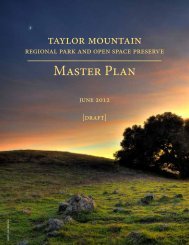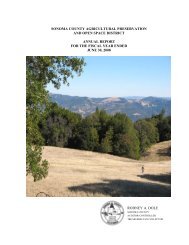Initial Study MND - Sonoma County Agricultural Preservation and ...
Initial Study MND - Sonoma County Agricultural Preservation and ...
Initial Study MND - Sonoma County Agricultural Preservation and ...
Create successful ePaper yourself
Turn your PDF publications into a flip-book with our unique Google optimized e-Paper software.
Taylor MountainINITIAL STUDY/MITIGATED NEGATIVE DECLARATIONapproved bank. The wetl<strong>and</strong> replacement ratio depends on the level of impact <strong>and</strong> quality ofthe impacted wetl<strong>and</strong>. This will be determined by resource agencies during the permittingphase of the project. S36 – Maintain minimum setbacks from wetl<strong>and</strong>s for all new development. Adequatevegetated buffers must be maintained or established for existing or new development. (SeeTable 3 in Section 5.10.1 of the Master Plan for specific setback requirements.) S37 – New trails shall be located well away from headcuts.Operational Phase S38 – The spread of invasive plant populations in wetl<strong>and</strong> habitats shall be prevented. S39 – Remove Himalayan blackberry in wetl<strong>and</strong>s where opportunities to do so arise inconjunction with native plant restoration. S40 – Monitor high-priority wetl<strong>and</strong> sites for non-native species, including pennyroyal <strong>and</strong>velvet grass (which are not listed as moderate or high priority for the property but areconsidered invasive in wetl<strong>and</strong>s). If these are found to be increasing, remove by manualmethods on an annual basis where they are encroaching on native plant populations. S78 – Water quality, quantity, <strong>and</strong> streamflow patterns shall be protected by providingadequate riparian buffers <strong>and</strong> minimizing instream disturbances from humans <strong>and</strong> livestock. S267 – Place seasonal limitations on trails through wetl<strong>and</strong> habitats. Trails should be closedor their use restricted if during the wet season fresh erosion <strong>and</strong>/or vegetation trampling arevisible.Implementation of the Master Plan’s avoidance <strong>and</strong> minimization measures would ensure thatpotential impacts on protected wetl<strong>and</strong>s are less than significant.d. Would the project interfere substantially with the movement of any native resident ormigratory fish or wildlife species or with established native resident or migratory wildlifecorridors, or impede the use of wildlife nursery sites?LESS THAN SIGNIFICANT. Within the property, streams are intermittent, precluding thepossibility of a migratory population of salmonids or resident trout. The ephemeral streams donot provide adequate habitat for fish during the warm summer months. Other wildlife such asdeer, mountain lions, raccoons, opossums <strong>and</strong> skunks can use the seasonal drainages asmovement corridors because water is available in some wet areas on the mountain <strong>and</strong> introughs for cattle.The Master Plan includes a provision (S76) to remove non-critical fencing on the property.Some additional cross fencing could be installed on the property as part of the Master Plan.Fencing has the potential to interfere with wildlife movement, unless it is constructed towildlife-friendly fencing st<strong>and</strong>ards that would not prohibit wildlife movement. Wildlife-friendlyfencing uses non-barbed wire for the upper <strong>and</strong> lower str<strong>and</strong>s of fencing. This fencing would beused for any cross fencing installed. However, perimeter fencing is not of this type since smallercalves can escape underneath the fence without barbed wire. Since any perimeter fencing thatFinal B-64 September 2012







